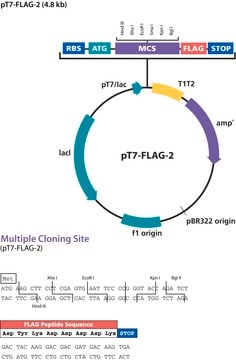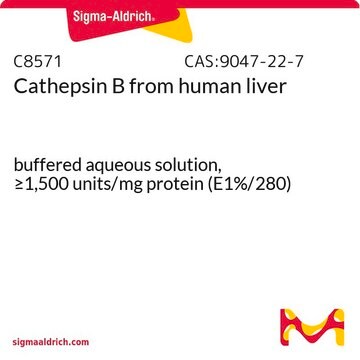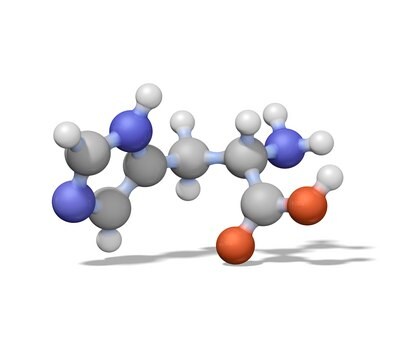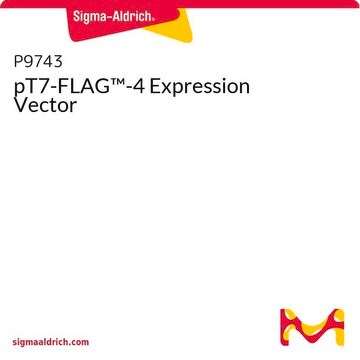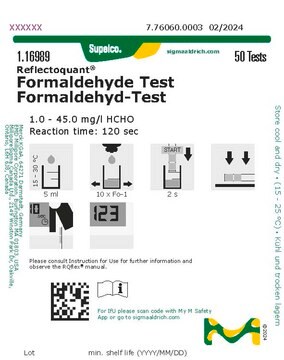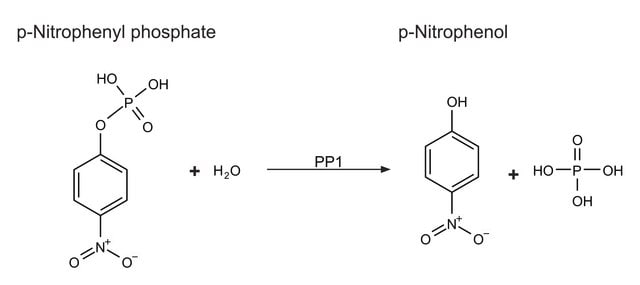E8408
pFLAG-CTC™ Expression Vector
Bacterial vector for cytoplasmic expression of C-terminal FLAG fusion proteins
Sign Into View Organizational & Contract Pricing
Select a Size
All Photos(2)
Select a Size
Change View
About This Item
UNSPSC Code:
12352200
Recommended Products
tag
FLAG® tagged
grade
Molecular Biology
for molecular biology
form
buffered aqueous solution
shipped in
dry ice
storage temp.
−20°C
General description
The pFLAG-CTC™ Expression Vector is a 5.3 kb E. coli expression vector used for cytoplasmic expression of a properly inserted open reading frame as a C-terminal FLAG® fusion protein. The FLAG epitope is a small, hydrophilic 8 amino acid tag (DYKDDDDK) that provides for sensitive detection and high quality purification using ANTI-FLAG products.
C-terminal FLAG fusion proteins may be purified using Monoclonal ANTI-FLAG M2, Catalog Number F3165, and ANTI-FLAG M2 Affinity Gel, Catalog Number A2220.
The pFLAG-CTS-BAP Control Plasmid is a 6.7 kb vE. coli plasmid used for efficient and controlled periplasmic expression of C-terminal FLAG-BAP fusion protein.
Vector Maps and Sequences
C-terminal FLAG fusion proteins may be purified using Monoclonal ANTI-FLAG M2, Catalog Number F3165, and ANTI-FLAG M2 Affinity Gel, Catalog Number A2220.
The pFLAG-CTS-BAP Control Plasmid is a 6.7 kb vE. coli plasmid used for efficient and controlled periplasmic expression of C-terminal FLAG-BAP fusion protein.
Vector Maps and Sequences
Components
- pFLAG-CTC™ Expression Vector 10 μg (E5394) is supplied as 0.5 mg/ml in 10 mM Tris-HCl (pH 8.0) with 1 mM EDTA.
- pFLAG-CTS™-BAP Control Plasmid 1 μg (P7707) is supplied as 0.5 mg/ml in 10 mM Tris-HCl (pH 8.0) with 1 mM EDTA.
Principle
The promoter-regulatory region of the strong tac promoter (a hybrid of the trp and lac promoters from E.coli) drives transcription of ORF-FLAG fusion constructs. Control of transcription is regulated by the presence of the lacO sequences and inclusion of the lac repressor gene (lacI) on the plasmid.
Legal Information
FLAG is a registered trademark of Merck KGaA, Darmstadt, Germany
pFLAG-CTC is a trademark of Sigma-Aldrich Co. LLC
pFLAG-CTS is a trademark of Sigma-Aldrich Co. LLC
related product
Storage Class Code
10 - Combustible liquids
Choose from one of the most recent versions:
Certificates of Analysis (COA)
Lot/Batch Number
Don't see the Right Version?
If you require a particular version, you can look up a specific certificate by the Lot or Batch number.
Already Own This Product?
Find documentation for the products that you have recently purchased in the Document Library.
Construction of expression vectors to produce affinity-tagged proteins in Pseudomonas.
Robin Couch et al.
BioTechniques, 32(6), 1230-1230 (2002-06-21)
Veronika Kucharova et al.
PloS one, 8(6), e66429-e66429 (2013-07-11)
mRNA stability is one among many parameters that can potentially affect the level of recombinant gene expression in bacteria. Blocking of the entire prokaryotic transcription machinery by addition of rifampicin is commonly used in protocols for analysis of mRNA stability.
Rachel L Olsen et al.
Veterinary microbiology, 164(1-2), 164-170 (2013-02-26)
The human pathogens enterohemorrhagic and enteropathogenic Escherichia coli (EHEC and EPEC), as well as the mouse pathogen Citrobacter rodentium encode type III secretion system (T3SS) effector proteins to promote their survival in the infected host. The mechanisms of action and
Ram P Garg et al.
Microbiology (Reading, England), 156(Pt 2), 472-483 (2009-11-07)
Streptomyces antibiotic regulatory proteins (SARPs) have been shown to activate transcription by binding to a tandemly arrayed set of heptameric direct repeats located around the -35 region of their cognate promoters. Experimental evidence is presented here showing that vlmI is
Koichiro Komiya et al.
Arthritis research & therapy, 7(6), R1158-R1173 (2005-11-10)
ADAMs (a disintegrin and metalloproteinases) comprise a new gene family of metalloproteinases, and may play roles in cell-cell interaction, cell migration, signal transduction, shedding of membrane-anchored proteins and degradation of extracellular matrix. We screened the mRNA expression of 10 different
Related Content
Bacterial Expression Vectors: tac Promoter System
Our team of scientists has experience in all areas of research including Life Science, Material Science, Chemical Synthesis, Chromatography, Analytical and many others.
Contact Technical Service